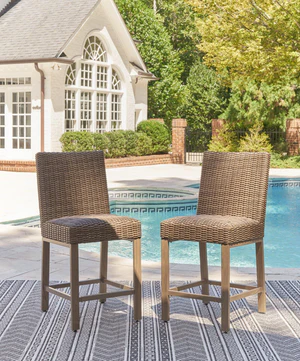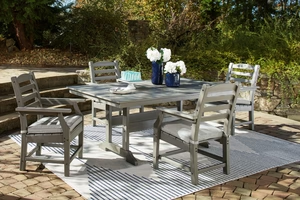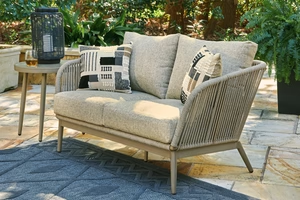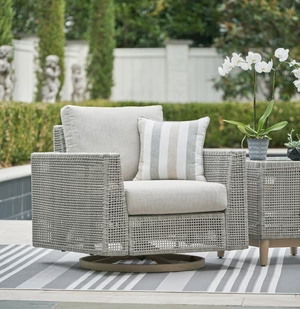Wondering when you should replace your outdoor furniture? Signs of wear and tear, such as faded cushions, rust, mold, and structural issues, are clear indicators of when you should replace your outdoor furniture. Recognizing these signs early can ensure your outdoor space remains safe and inviting. Let’s explore the top 5 signs to watch out for: when should you replace your outdoor furniture?
Key Takeaways
-
Worn-out cushions, mold and mildew, and structural weakness are key indicators that outdoor furniture needs replacement for safety and comfort.
-
Regular maintenance practices, such as cleaning and using protective covers, can significantly extend the lifespan of outdoor furniture.
-
Choosing high-quality, weather-resistant materials is essential for ensuring durability and reducing the need for frequent replacements.
Worn-Out Cushions

Worn-out cushions clearly indicate that your outdoor furniture needs attention. Faded, stained, torn, or misshapen cushions detract from the aesthetic appeal of your garden furniture and compromise comfort. Imagine sinking into a patio chair only to feel the discomfort of a lumpy or flat cushion – it’s not the relaxing experience you desire.
Replacing both cushion covers and foam inserts can breathe new life into your outdoor seating. This rejuvenation not only restores comfort but also offers a chance to replace cushions and update your space’s look. Opt for new cushions in weather-resistant fabrics to enhance durability and maintain a fresh appearance longer. Customization opportunities abound, allowing you to match new designs with your existing outdoor decor, creating a cohesive and stylish environment.
When cushions are ripped, stained, or faded beyond repair, it’s a clear sign that it’s time to replace them. New patio furniture cushions can transform your outdoor space, making it inviting and comfortable once again. Don’t let outdated, uncomfortable cushions ruin your outdoor experience – invest in new pieces that reflect your style and provide the comfort you deserve.
Mold and Mildew
Before:
Mold and mildew are more than just unsightly – they pose serious health risks, including sneezing, coughing, and itchy eyes, and can even trigger asthma. If you find mold on your outdoor furniture, especially on cushions, it’s crucial to act promptly. Replacing moldy cushions or even the entire furniture piece is necessary to avoid health risks.
After:
Mold and mildew are more than just unsightly – they pose serious health risks, including:
-
sneezing
-
coughing
-
itchy eyes
-
triggering asthma
If you find mold on your outdoor furniture, especially on cushions, it’s crucial to act promptly. Replacing moldy cushions or even the entire furniture piece is necessary to avoid health risks.
Preventing mold growth involves proper care and maintenance. Mold thrives in damp, dark environments, so ensure your outdoor furniture is kept dry and clean. Regularly cleaning and using waterproof covers can help prevent mold from establishing. These steps help prolong the life of your outdoor furniture and maintain a healthy, inviting outdoor space.
Rust and Corrosion
Rust and corrosion indicate that your metal patio furniture might need replacing. When left unchecked, rust and corrosion can compromise the structural integrity of your furniture, making it unsafe to use. Large or persistent rust spots often mean it’s more effective to replace the furniture rather than attempting repairs.
However, minor rust spots can be managed with timely intervention. Scrubbing with a wire brush, cleaning, sanding lightly, and repainting can restore the look and function of your metal furniture. This can be a practical approach if the rust is not extensive. Consider aluminum frames with stainless-steel hardware for new purchases to avoid future rust issues.
Rust affects the aesthetic appeal of your furniture and indicates structural weakness. The quality degrades significantly with rust, making it unfit for use. Therefore, ensuring that your outdoor furniture is made from weather-resistant materials and regularly maintaining it can help prevent rust and prolong its lifespan.
Chipped Paint and Surface Damage
Chipped paint and surface damage are clear indicators that your outdoor furniture might need attention. When paint chips, it exposes the underlying material to the elements, leading to further deterioration. A compromised protective layer can lead to structural damage over time, especially if the furniture is frequently exposed to rain and dirt.
To protect your patio furniture from the elements, applying a fresh coat of paint or varnish can be an effective solution. However, depending on the severity of the damage, you might have to decide between repainting or replacing the furniture. Extensive damage might require replacing the outdoor furniture to ensure longevity and maintain aesthetic appeal.
Structural Weakness and Creaking
Structural weakness and creaking sounds are red flags that your outdoor furniture may need replacing. Signs of cracking and dry rot suggest that the material has deteriorated, compromising the furniture’s structural integrity. Creaking sounds when sitting or moving often indicate worn joints or an unstable structure.
Wobbliness or overall instability can be a safety hazard, posing risks to anyone using the furniture. Creaking in your outdoor chair might signal it’s time for a replacement. Tightening loose joints or lubricating moving parts can temporarily fix creaking but are often short-term solutions.
Unstable furniture can lead to accidents, making it crucial to address these issues promptly. Signs of structural weakness suggest replacing your outdoor furniture to ensure safety and comfort.
Factors Influencing Longevity
The longevity of outdoor furniture is influenced by several factors, including the quality of materials used, exposure to environmental conditions, and consistent maintenance practices. These factors assist in making informed decisions about purchasing and maintaining your outdoor furniture.
Material selection, climate considerations, and maintenance practices play key roles in ensuring your furniture lasts as long as possible.
Material Selection
Choosing the right materials for your outdoor furniture ensures durability and resistance against various environmental elements. Opt for weather-resistant materials like tropical hardwoods, cedar, and redwood, which can withstand harsh conditions and require minimal maintenance.
High-density polyethylene (HDPE) is another excellent choice, especially for synthetic wicker and other outdoor furniture. It offers exceptional UV resistance and durability, making it a reliable option for long-lasting outdoor pieces.
Choosing the right materials significantly extends the lifespan of your outdoor furniture and reduces the need for frequent replacements.
Climate Considerations
Climate plays a significant role in the longevity of outdoor furniture. Extreme weather conditions, such as harsh winters or intense sun, can accelerate deterioration. Regular inspections can help identify damage early, allowing for timely repair or replacement.
Proper care and initiatives, such as using protective covers and storing furniture indoors during extreme weather, can significantly extend the life of your outdoor furniture. By understanding how different climates affect your furniture, you can take proactive steps to protect your investment.
Maintenance Practices
Regular maintenance practices are vital for preserving the comfort and appearance of your outdoor furniture. Here are some simple actions you can take:
-
Clean with mild soap and water to prevent paint deterioration and maintain the furniture’s appearance.
-
Use waterproof covers to protect your furniture from the elements.
-
Store cushions indoors when not in use to help prevent mold growth.
-
Regularly check for any signs of wear and tear to address issues promptly.
By following these practices, you can extend the life of your furniture and keep it looking great.
Applying a quality primer before painting and using rust converters can help prevent further corrosion on metal furniture. By following these maintenance practices, you can ensure your outdoor furniture remains in excellent condition with minimal upkeep.
Evaluating Existing Furniture

Assessing the condition of your existing furniture is essential to determine whether it needs refreshing or replacement. Look for visible signs of wear, such as sagging, fraying, or severe damage.
Compromised structural integrity or safety might mean it’s time to replace your outdoor furniture.
Refreshing Techniques
Refreshing your outdoor furniture can significantly enhance the overall look and usability of your outdoor space. Rearranging furniture to create conversation areas or adding new coats of paint can revitalize aged furniture. Replacing worn cushions can also improve comfort and give your outdoor seating a fresh appearance.
Refreshing your outdoor furniture creates a fresh and inviting atmosphere for gatherings, making your outdoor space more enjoyable. These small changes can make a big difference without the need to replace outdoor furniture completely.
When Replacement Is Necessary
There comes a point when replacing your outdoor furniture is the best option. Visible signs of severe damage, instability, or outdated style indicate it’s time to invest in new pieces. Frequent re-sanding, re-painting, or re-varnishing indicates that your furniture may need replacing.
Replacing old furniture enhances the aesthetic of your outdoor space and meets new comfort needs. If you can’t remember when you purchased your patio furniture, it might be time to consider new furniture that reflects your current style and provides the comfort you desire.
Selecting Quality Materials
Choosing quality materials ensures the longevity of outdoor furniture. Teak, for instance, is highly regarded for its durability and resistance to rot. Aluminum furniture is popular due to its lightweight and rust-resistant properties, often featuring a powder-coated finish for enhanced durability.
High-density polyethylene (HDPE) and marine grade polymer (MGP) are robust choices for synthetic wicker and plastic patio furniture, offering great resistance to fading and cracking. Materials that suit your climate and maintenance preferences ensure your outdoor furniture remains in excellent condition for years.
Ensuring Comfort and Style

Comfort and style are key considerations when selecting outdoor furniture. High-density foam cushions covered in weather-resistant fabric can significantly improve the comfort and longevity of your outdoor seating. Durable materials like teak or aluminum keep your furniture stylish and functional for years.
Accessories like throws, pillows, and outdoor rugs add personal expression and enhance comfort in your outdoor space. Shading solutions like umbrellas or pergolas improve comfort by reducing sun exposure, making your outdoor area more enjoyable.
Investing in high-quality items can elevate the overall aesthetic, making your outdoor space feel more upscale.
Budget-Friendly Options
Enhancing your outdoor space can be budget-friendly. Thrifted finds and upcycled items can enhance your outdoor space without high costs. Decorative elements like thrifted lanterns or unique trays enhance the visual interest of your patio without significant expenditure.
DIY projects like painting old furniture or creating outdoor art personalize your patio while saving money. Regular maintenance and cleaning can keep your outdoor space looking fresh and inviting, contributing to its overall appeal.
Creativity and resourcefulness allow you to create a beautiful outdoor space on a budget.
Get Your Outdoor Furniture At Golden Linens & Furniture Today!

Ready to transform your outdoor space with high-quality, stylish furniture? At Golden Linens & Furniture, we offer a wide range of new outdoor furniture to suit every taste and budget. From durable aluminum furniture to elegant teak pieces, our selection ensures you find the perfect fit for your patio, garden, or backyard.
Don’t let broken furniture or outdated designs hold you back. Visit us today and discover how our new patio furniture can elevate your outdoor living experience.
Summary
In summary, knowing when to replace your outdoor furniture is crucial for maintaining a beautiful, comfortable, and safe outdoor space. From worn-out cushions to structural weaknesses, recognizing the signs can help you make informed decisions. Selecting quality materials, considering climate impacts, and following proper maintenance practices can extend the life of your outdoor furniture. Whether refreshing or replacing, ensuring comfort and style doesn’t have to be expensive. Invest in quality pieces or explore budget-friendly options to create your ideal outdoor oasis.
Frequently Asked Questions
How often should I replace my outdoor cushions?
You should replace your outdoor cushions when they exhibit fading, tearing, or loss of shape, as this ensures continued comfort and enhances the visual appeal of your outdoor space.
What are the health risks of mold on outdoor furniture?
Mold on outdoor furniture poses serious health risks, including respiratory issues like sneezing, coughing, and asthma exacerbation. Therefore, it's crucial to address mold growth promptly to ensure a safe environment.
Can minor rust spots on metal furniture be repaired?
Yes, minor rust spots on metal furniture can be effectively repaired by scrubbing with a wire brush, cleaning, lightly sanding, and repainting to prevent further damage.
What materials are best for durable outdoor furniture?
For durable outdoor furniture, choose materials like tropical hardwoods, teak, HDPE, and aluminum, as they offer excellent resistance to weather and wear. Selecting these materials will ensure your furniture stands the test of time.
How can I enhance my outdoor space on a budget?
To enhance your outdoor space on a budget, focus on incorporating thrifted items, upcycled materials, and engaging in DIY projects. These strategies will allow you to create a stylish area without significant expenses.


